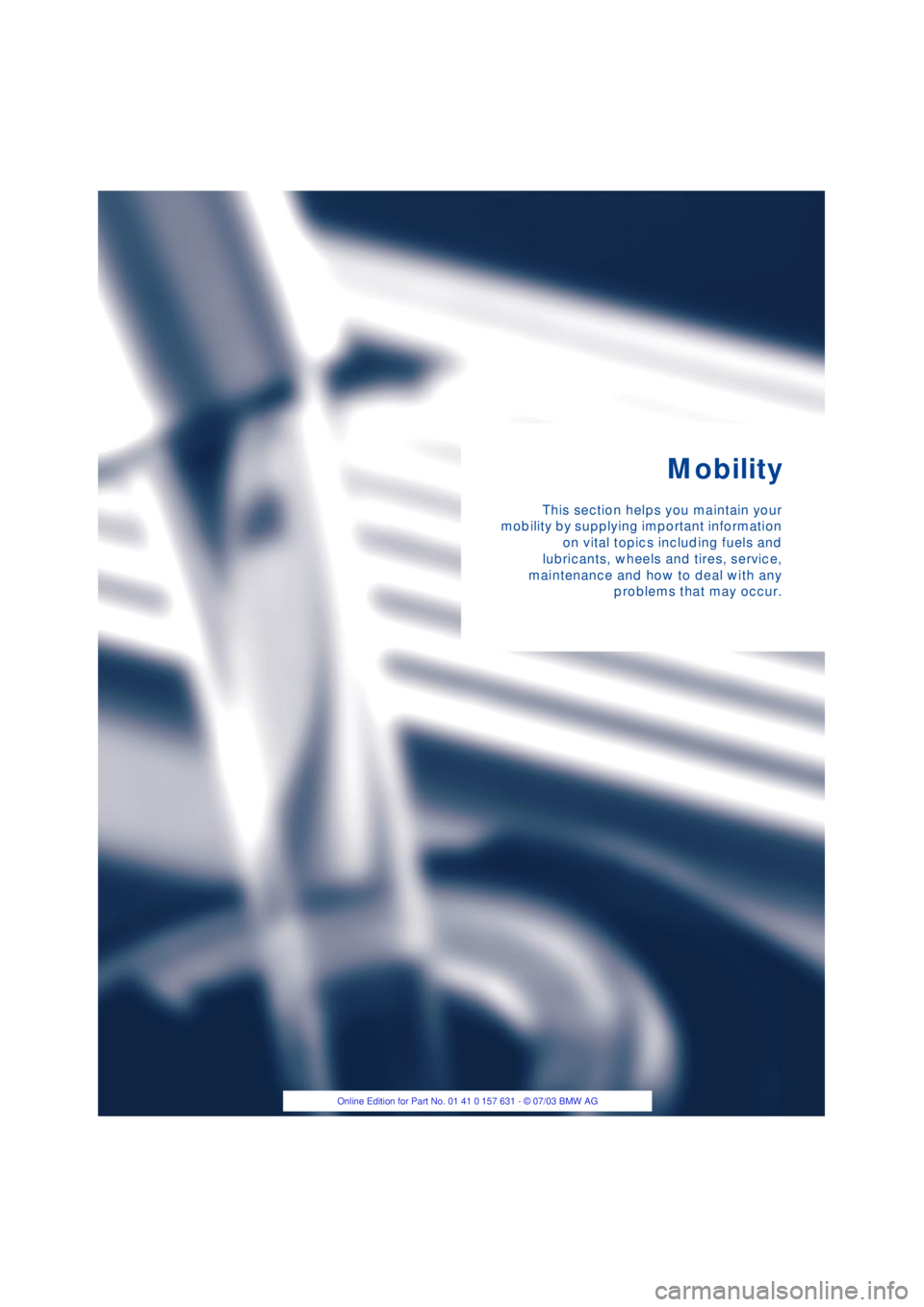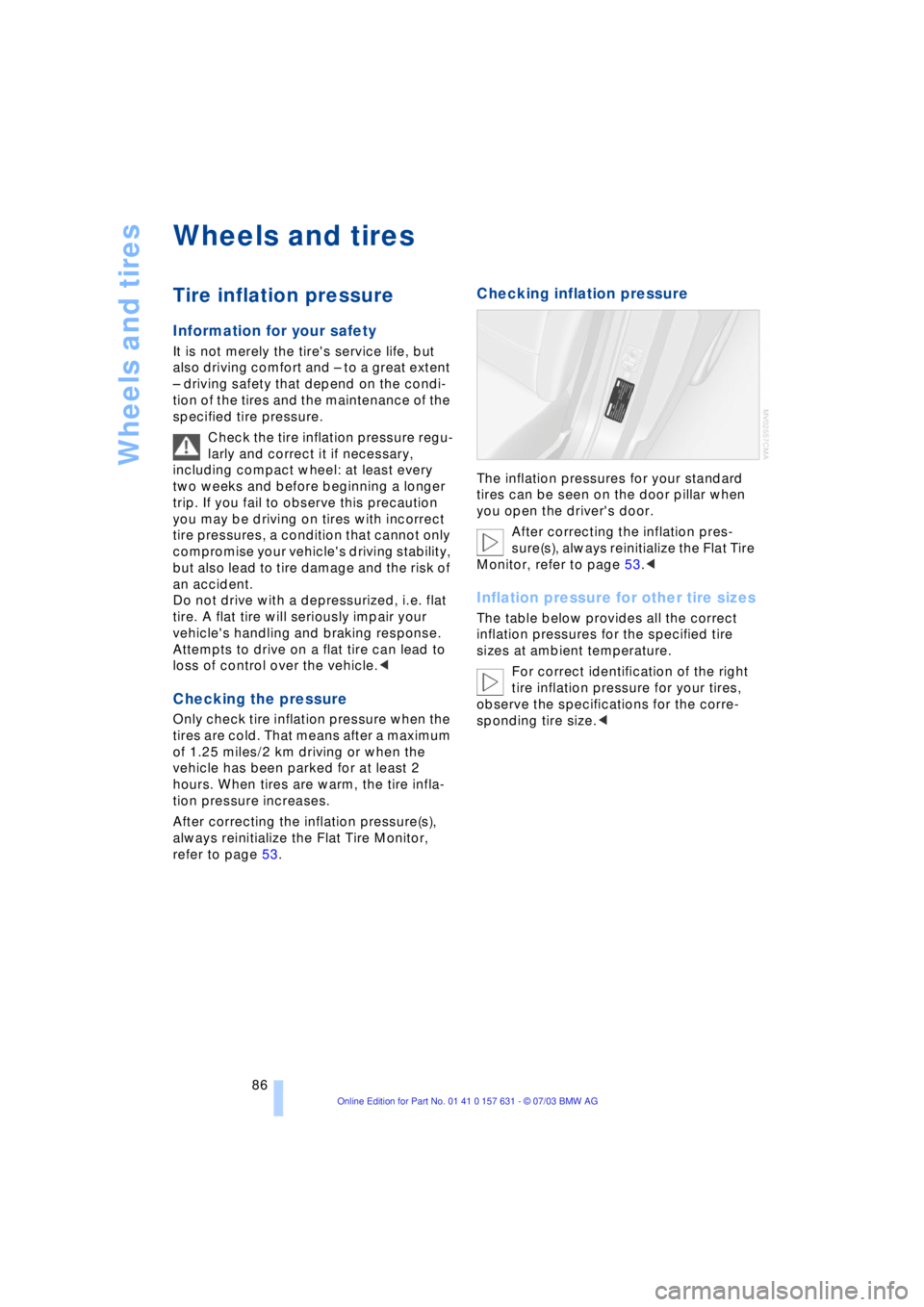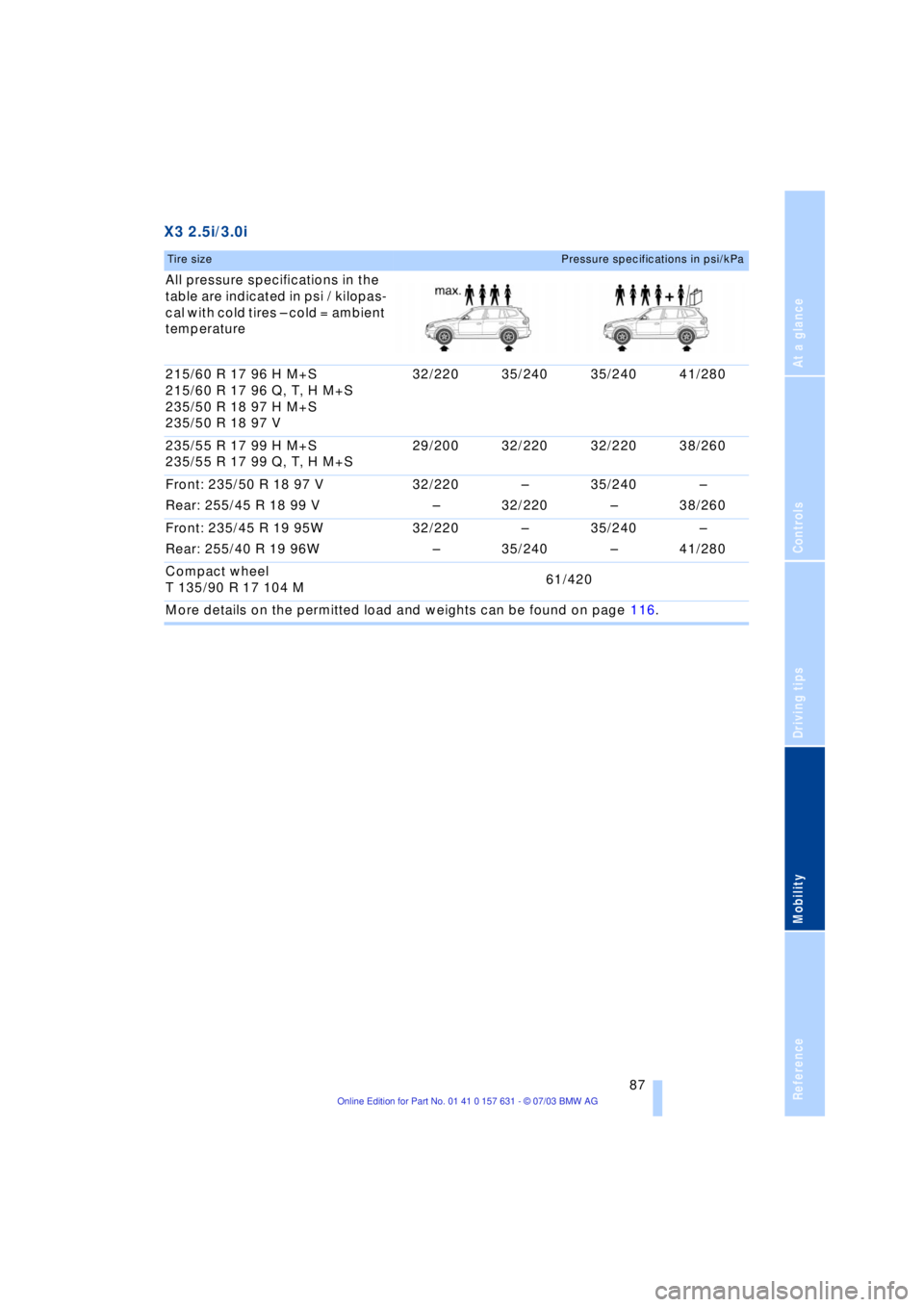2004 BMW X3 2.5I SAV wheel
[x] Cancel search: wheelPage 82 of 132

Things to remember when driving
80
Driving on bad roads
Your BMW X3 is at home on all paved and
unpaved roads. It combines all-wheel drive
with the advantages of a normal passenger
car.
Driving on unpaved terrain can cause
damage to the vehicle.<
When you are driving on bad roads, there
are a few points which you should strictly
observe Ñ for your own safety, for that of
your passengers, and for the safety of the
vehicle:
>Familiarize yourself with the vehicle
before you begin driving. Do not take
risks with the vehicle under any circum-
stances
>Always adapt the driving speed to the
road conditions. The more steep and
uneven the roadway is, the lower the
speed should be
>You can operate your vehicle on uphill
and downhill gradients with a maximum
slope of 50 %. If you wish to drive on
uphill and downhill grades of this
nature, make sure beforehand that the
engine oil and coolant levels are near
the max mark, refer to pages 94 and 96
>For very steep downhill driving, use Hill
Descent Control HDC, refer to page 51.
Driving off is possible on upward
inclines of up to 33%.
The permitted side inclination is 50 %
>While driving, watch carefully for obsta-
cles such as rocks or holes. Try to avoid
these obstacles whenever possible
>Avoid that the body makes contact with
the ground, e.g. on the crests of hills
and bumpy roads
>Do not drive in water that is deeper than
20 in/50 cm. If you must drive through
water up to that depth, drive at a walk-
ing speed and do not stop.
After leaving the water, press on the
footbrake gently several times while
driving at a low speed. The brake appli-
cations will help to dry the brakes, thus
preventing a reduction in braking per-
formance caused by the moisture. For cleaning the handbrake, apply the
lever slightly at approx. 25 mph/40 km/
h and continue to drive for approx. 200
yards/200 meters, provided that traffic
conditions allow you to do so.
Please bear the following points in mind
after driving on poor roads, in order to pre-
serve the road safety of your BMW:
>Clean the heavy dirt from the body
>Clean mud, snow, ice and other materi-
als from the wheels and tires. Check the
tires for damage.
Page 85 of 132

Mobility
This section helps you maintain your
mobility by supplying important information
on vital topics including fuels and
lubricants, wheels and tires, service,
maintenance and how to deal with any
problems that may occur.
Page 88 of 132

Wheels and tires
86
Wheels and tires
Tire inflation pressure
Information for your safety
It is not merely the tire's service life, but
also driving comfort and Ð to a great extent
Ð driving safety that depend on the condi-
tion of the tires and the maintenance of the
specified tire pressure.
Check the tire inflation pressure regu-
larly and correct it if necessary,
including compact wheel: at least every
two weeks and before beginning a longer
trip. If you fail to observe this precaution
you may be driving on tires with incorrect
tire pressures, a condition that cannot only
compromise your vehicle's driving stability,
but also lead to tire damage and the risk of
an accident.
Do not drive with a depressurized, i.e. flat
tire. A flat tire will seriously impair your
vehicle's handling and braking response.
Attempts to drive on a flat tire can lead to
loss of control over the vehicle.<
Checking the pressure
Only check tire inflation pressure when the
tires are cold. That means after a maximum
of 1.25 miles/2 km driving or when the
vehicle has been parked for at least 2
hours. When tires are warm, the tire infla-
tion pressure increases.
After correcting the inflation pressure(s),
always reinitialize the Flat Tire Monitor,
refer to page 53.
Checking inflation pressure
The inflation pressures for your standard
tires can be seen on the door pillar when
you open the driver's door.
After correcting the inflation pres-
sure(s), always reinitialize the Flat Tire
Monitor, refer to page 53.<
Inflation pressure for other tire sizes
The table below provides all the correct
inflation pressures for the specified tire
sizes at ambient temperature.
For correct identification of the right
tire inflation pressure for your tires,
observe the specifications for the corre-
sponding tire size.<
Page 89 of 132

Reference
At a glance
Controls
Driving tips
Mobility
87
X3 2.5i/3.0i
Tire sizePressure specifications in psi/kPa
All pressure specifications in the
table are indicated in psi / kilopas-
cal with cold tires Ð cold = ambient
temperature
215/60 R 17 96 H M+S
215/60 R 17 96 Q, T, H M+S
235/50 R 18 97 H M+S
235/50 R 18 97 V32/220 35/240 35/240 41/280
235/55 R 17 99 H M+S
235/55 R 17 99 Q, T, H M+S29/200 32/220 32/220 38/260
Front: 235/50 R 18 97 V
Rear: 255/45 R 18 99 V32/220
ÐÐ
32/22035/240
ÐÐ
38/260
Front: 235/45 R 19 95W
Rear: 255/40 R 19 96W32/220
ÐÐ
35/24035/240
ÐÐ
41/280
Compact wheel
T 135/90 R 17 104 M61/420
More details on the permitted load and weights can be found on page 116.
Page 90 of 132

Wheels and tires
88
Tire identification marks
Knowledge of the labeling on the side of
the tire makes it easier to identify and
choose the right tires.
Tire size
Speed code letter
T = up to 118 mph/190 km/h
H = up to 131 mph/210 km/h
V = up to 150 mph/240 km/h
W = up to 167 mph/270 km/h
Y = up to 186 mph/300 km/h
Tire Identification Number
Tires with DOT codes meet the guidelines
of the U.S. Department of Transport.
DOT code:
Tire age
The tire's date of manufacture is indicated
on the sidewall:
DOT ... 3603 indicates that a tire was man-
ufactured in week 36 of the year 2003.
BMW recommends that you replace all
tires after 6 years at the latest, indepen-
dently of the fact that tires can reach an age
of 10 years.
Uniform Tire Quality Grading
Quality grades can be found where appli-
cable on the tire sidewall between tread
shoulder and maximum section width.
For example:
Tread wear 200 Traction AA
Temperature A
DOT Quality Grades
Treadwear
Traction AA A B C
Temperature A B C
All passenger car tires must conform
to Federal Safety Requirements in
addition to these grades.<
Treadwear
The treadwear grade is a comparative rat-
ing based on the wear rate of the tire when
tested under controlled conditions on a
specified government test course.
For example, a tire graded 150 would wear
one and one-half (1 g) times as well on the
government course as a tire graded 100.
The relative performance of tires depends
upon the actual conditions of their use,
however, and may depart significantly from
the norm due to variations in driving habits,
service practices and differences in road
characteristics and climate.
Traction
The traction grades, from highest to lowest,
are AA, A, B, and C.
Those grades represent the tire's ability to
stop on wet pavement as measured under
controlled conditions on specified govern-
ment test surfaces of asphalt and concrete.
A tire marked C may have poor traction
performance.
The traction grade assigned to this
tire is based on straight-ahead brak-
ing traction tests, and does not include
acceleration, cornering, hydroplaning, or
peak traction characteristics.<
Temperature
The temperature grades are A Ð the
highest Ð B, and C, representing the tire's e.g.
Nominal width
in mm
Aspect ratio in X
Radial type
Rim diameter in inches
Load rating
(not on ZR tires)
Speed rating
(before R on ZR tires)
205/60 R1591W
e.g.
Manufacturer code
for tire make
Tire size and
tire design
Tire ageDOT xxxx xxx 3603
Page 91 of 132

Reference
At a glance
Controls
Driving tips
Mobility
89
resistance to the generation of heat and its
ability to dissipate heat when tested under
controlled conditions on a specified indoor
laboratory test wheel.
Sustained high temperature can cause the
material of the tire to degenerate and
reduce tire life, and excessive temperature
can lead to sudden tire failure. The grade C
corresponds to a level of performance
which all passenger car tires must meet
under the Federal Motor Vehicle Safety
Standard No. 109. Grades B and A repre-
sent higher levels of performance on the
laboratory test wheel than the minimum
required by law.
The temperature grade for this tire is
established for a tire that is properly
inflated and not overloaded. Excessive
speed, underinflation, or excessive load-
ing, either separately or in combination,
can cause heat buildup and possible tire
failure.<
M+S
Winter and all-season tires.
These have better winter properties than
summer tires.
Tire condition
Inspect your tires frequently for treadwear,
signs of damage and for foreign objects
lodged in the tread. Check the tread pat-
tern depth.
Tire tread
The tread depth should not drop below
0.12 in/3 mm, although, for example, Euro-
pean legislation only specifies a minimum
tread depth of 0.063 in/1.6 mm. At tread
depths below 0.12 in/3 mm, there is an
increased risk of high-speed hydroplaning,
even when only small amounts of water are
present on the road surface.
As winter tires display a noticeable loss in
their ability to cope with cold-weather driv-
ing conditions once the tread wears to
below 0.16 in/4 mm, to ensure continued safety you should always have such tires
replaced.
Wear indicators at the tread-groove base,
refer to arrow, are distributed over the tire's
circumference and are marked on the tire
sidewall with TWI Ð Tread Wear Indicator.
At a tread depth of 0.063 in/1.6 mm these
indicators, signal that the tires have
reached the legally permissible wear limit.
Tire damage
Unusual vibrations encountered dur-
ing normal vehicle operation can indi-
cate tire failure or some other vehicle
defect. This can, for example, be caused by
driving over curbs. These kinds of prob-
lems may also be signaled by other
changes in vehicle response, such as a
strong tendency to pull to the left or right.
Should this occur, respond by immediately
reducing your speed. Proceed carefully to
the nearest BMW Sports Activity Vehicle
Center or professional tire center, or have
the vehicle towed in to have it, its wheels
and tires inspected.
Tire damage, extending to sudden and
complete loss of pressure in extreme
cases, can pose a potentially lethal safety
hazard for the vehicle's occupants and
other road users alike.<
Replacing wheels/tires
Unprofessional attempts by laymen to
service tires can lead to damage and
accidents.
Have this work performed by skilled pro-
fessionals only. All BMW Sports Activity
Vehicle Centers will be happy to help you
Page 92 of 132

Wheels and tires
90 with specialized knowledge and corre-
sponding equipment.<
The correct wheel and tire combination
affects various systems whose function
would otherwise be impaired, e.g. ABS,
DSC or xDrive.
Have the wheel and tire assemblies bal-
anced every time either a wheel or a tire is
replaced.
BMW does not recommend the use of
retreaded tires, as otherwise driving
safety may be reduced. Possible variations
in the design and the age Ð which could be
substantial Ð of the carcasses can lead to
unusually rapid wear.<
The right wheels and tires
BMW recommends that you use only
wheel and tire combinations that
BMW has tested and approved for your
particular vehicle. Variations in factors such
as manufacturing tolerances mean that
even wheels and tires with identical official
size ratings could actually have different
dimensions than the approved units Ð these
differences could lead to body contact, and
with it the risk of severe accidents. If non-
approved wheels and tires are used, BMW
cannot evaluate their suitability, and there-
fore cannot be held liable for driving
safety.<
To maintain good handling and vehicle
response, use only tires of a single tread
configuration from a single manufacturer.
After a flat tire, always remember to have
the specified wheel and tire combination
remounted on the vehicle as soon as pos-
sible.
Recommended tire brands
BMW tests certain tire brands for each tire
size, classifies them as road-safe and
approves them. You can obtain a list of
these from your BMW Sports Activity Vehi-
cle Center. Observe any country-specific
regulations, e.g. on making a correspond-
ing entry in the vehicle documents.
The factory-mounted tires have been spe-
cially selected to provide optimized perfor-mance when installed on your vehicle; if
properly cared for, they will provide a com-
bination of safety and excellent ride com-
fort.
Special characteristics of winter
tires
BMW recommends winter tires for use in
cold winter driving conditions. Although all-
season M+S tires provide better winter
traction than summer tires, they generally
fail to provide the same levels of cold-
weather performance as winter tires.
When switching to winter tires, observe the
descriptions at Tire condition and Replac-
ing wheels/tires, refer to page 89.
Observing speed ratings
Never exceed the maximum speed for
which the winter tires are rated.
Unprofessional attempts by laymen to ser-
vice tires can lead to damage and acci-
dents. Have this work performed by skilled
professionals only. The technicians at your
BMW Sports Activity Vehicle Center will be
glad to assist you with the required profes-
sional knowledge and specialized equip-
ment.<
Storage
Store wheels or tires in a cool, dry place,
protecting them against light whenever
possible. Protect the tires against contact
with oil, grease and fuel.
Do not exceed the maximum tire inflation
pressure specified on the side of the tire.
Snow chains*
Do not exceed a vehicle speed of
30 mph/50 km/h with snow chains
mounted.<
Only certain snow chains have been tested
by BMW and classified and approved as
safe. You can obtain a list of these from
your BMW Sports Activity Vehicle Center.
BMW recommends the use of approved
narrow-link snow chains only. These snow
chains are approved exclusively for use on
Page 93 of 132

Reference
At a glance
Controls
Driving tips
Mobility
91
summer or winter tires in pairs on the rear
wheels.
Observe the manufacturer's instructions
when installing snow chains.
After mounting snow chains, do not
initialize the Flat Tire Monitor.
When you are driving with snow chains, it
can be beneficial to switch off DSC briefly,
refer to page 51.<